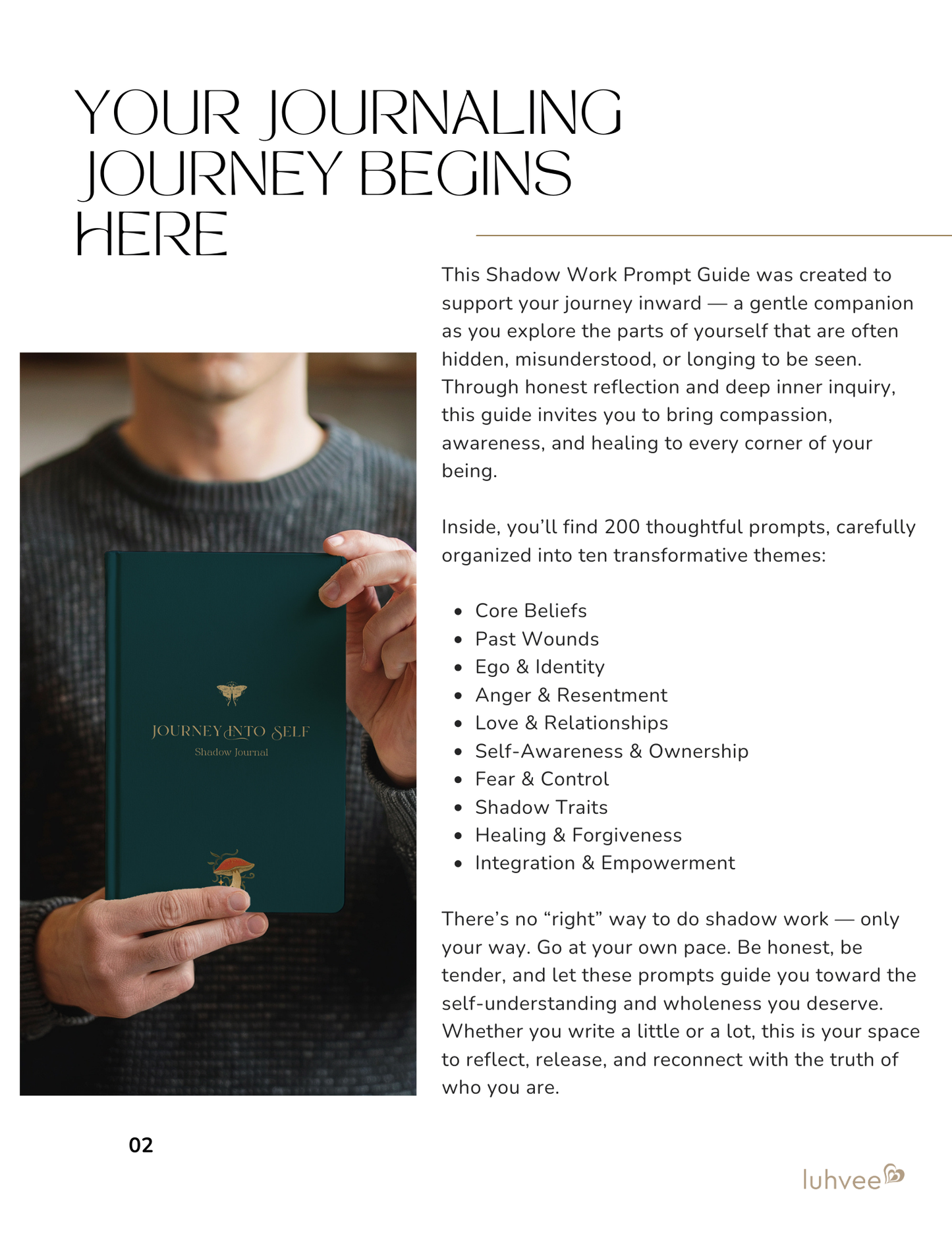luhvee.com
200 Shadow Work Prompts Guide— Digital Download
200 Shadow Work Prompts Guide— Digital Download
Couldn't load pickup availability
Prompts for Self-Discovery & Healing
Get to know yourself better with our Shadow Work Prompt Guide, a gentle yet powerful tool to help you explore the hidden parts of yourself with kindness, honesty and courage. The prompts are designed for a deep dive into your subconscious and self-awareness, for meaningful personal growth.
What This Guide Includes:
Inside you’ll find 200 prompts divided into 10 themes. Whether you’re just starting your shadow work journey or deepening an existing practice, this guide is the perfect space to journal, reflect and reconnect with yourself. It also encourages creative expression (art or music) as part of the shadow work process to access deeper layers of healing.
10 Transformative Themes:
- Core Beliefs
- Past Wounds
- Ego & Identity
- Anger & Resentment
- Love & Relationships
- Self-Awareness & Ownership
- Fear & Control
- Shadow Traits
- Healing & Forgiveness
-
Integration & Empowerment
How It Works:
Instant Digital Delivery: Once you complete your purchase, you’ll receive a downloadable PDF version of the guide. Print it out or use it alongside your favorite journal.
Flexible & Self-Paced: There’s no “right” way to do shadow work — only your way. Go at your own pace, revisit prompts when you need, and write as much or as little as feels right.
Why You’ll Love It:
This guide is more than a set of questions — it’s a transformative tool for growth. By facing your shadows with honesty and care, you open the door to greater self-awareness, release, and integration. Whether you’re new to shadow work or deepening your practice, these prompts will guide you toward healing, wholeness, and empowerment.
Share





Digital Download Shadow Work Prompts
More About Our Shadow Work Prompts
What is Shadow Work
Shadow work is a powerful therapeutic practice that invites you to explore the hidden parts of your personality – your shadow self. First introduced by Carl Jung, the concept of the shadow self refers to the parts of ourselves we hide, repress or deny – our darker impulses, unspoken desires and difficult emotions. By doing shadow work you can start to shine a light on these hidden aspects and gain more self awareness, personal growth and better mental health.
Using shadow work journal prompts and shadow work journaling prompts provides a structured and supportive way to start this journey. These prompts encourage honest self-reflection to help you uncover and integrate your shadow aspects. As you work through your shadow work journal you’ll find more authenticity and wholeness and be able to love all of yourself.The shadow self is a big and complex part of who we are, containing both the traits we consider negative and the ones we’ve been taught to suppress – even if they’re positive. This can include creative urges, deep emotional desires and qualities we’ve hidden to fit in or avoid judgment. The shadow self also holds onto painful memories, past traumas and patterns of self-criticism or self sabotage that impact our self esteem and daily life.
By using shadow work journal prompts you can start to gently explore these hidden layers. This process allows you to acknowledge your flaws and vulnerabilities without judgment and gain deeper understanding of yourself. As you bring these shadow aspects into the light you create space for healing, self compassion and lasting personal growth.
Before You Begin Shadow Work
Before you start your shadow work journey make sure you create a safe and nurturing environment for self-exploration. Set aside dedicated time for your shadow work journal and choose a quiet, comfortable space where you can reflect without distractions. Approach this practice with an open mind and a willingness to be completely honest with yourself, let go of self-judgment or criticism.
Starting with gentle shadow work journal prompts can help you ease into the process, build your confidence and comfort as you explore your shadow self. These journal prompts provide a supportive framework, guiding you step by step as you uncover and integrate the hidden aspects of your personality. Remember shadow work is a personal journey – move at your own pace and honor your feelings along the way.
How Does Shadow Work Work
Shadow work brings your unconscious thoughts, emotions and behaviors into conscious awareness – so you can heal, grow and live more authentically. Shadow work involves exploring your dark side and shadow traits, including the traits you may have suppressed or ignored to foster self-acceptance and emotional well-being. Here’s how it works and why it’s powerful:
1.1 Increases Self-Awareness
By looking at your hidden motivations and patterns you become more aware of what drives your actions. Recognising emotional reactions and negative feelings is key to self-awareness as it helps you understand how your fears and insecurities influence your decisions and overall well-being.
1.2 Heals Emotional WoundsShadow work allows you to process past traumas and emotional pain and develop more self-compassion and resilience. Repressed emotions and the inner critic can cause emotional wounds so it’s important to acknowledge and integrate these aspects for true healing.
1.3 Relationships
Understanding your triggers and projections helps you communicate more honestly and empathetically with others. Your self perception and core values impact present day relationships and personal life and how you connect and interact with those around you.
1.4 Confidence and Self-Love
Accepting all of yourself, even the parts you dislike, brings a sense of wholeness and self-acceptance. Understanding your inner desires and limiting beliefs can help build confidence and self-love by uncovering hidden motivations and challenging self-sabotaging patterns.
1.5 Hidden Potential
Shadow work can reveal strengths and talents you didn’t know you had. It can unlock hidden potential in both personal and professional life and work prompts can be a valuable tool for exploring workplace triggers and career growth.
Shadow work should be approached in a healthy way as part of a healing journey. Professional support may be helpful for deeper or more challenging issues so you have guidance and a safe space for reflection and growth.
1. Self-Awareness
Shadow work helps you recognize patterns, triggers and emotional reactions that are often rooted in past experiences. When you understand why you feel or behave a certain way you can choose differently.
2. Emotional Wounds
Unacknowledged pain doesn’t disappear – it hides in the shadows and often shows up as self-sabotage, anxiety or strained relationships. Shadow work creates space for those wounds to be seen, processed and ultimately healed.
3. Relationships
When you take responsibility for your own projections and triggers you’re less reactive and more compassionate. Shadow work allows you to communicate more honestly and connect more deeply – with others and with yourself.
4. Confidence & Self-Love
By accepting and integrating your “shadow” parts – the traits you’ve rejected, hidden or judged – you begin to see yourself as whole and worthy. This builds self-esteem and self-acceptance.Many of our strengths are buried with our wounds. As you do the work you may rediscover lost creativity, intuition, drive or inner wisdom that had been suppressed for years.
Shadow work isn’t always easy – but it is life-changing. It’s the courageous act of meeting yourself with honesty and compassion and choosing to grow from within.
What Is Shadow Work?
Shadow work is the practice of exploring the unconscious parts of yourself – your “shadow” – to better understand, heal and integrate all of who you are.
Coined by psychologist Carl Jung the “shadow” refers to the parts of ourselves we often hide or suppress – like shame, anger, fear, insecurity or past trauma. These parts live in the unconscious mind but still impact how we think, feel and behave. Shadow work can help you process traumatic experiences and childhood experiences that shape your adult behaviour. Reconnecting with your child self is an important part of healing wounds from early life.
Shadow work involves bringing these hidden aspects into the light through self reflection, journaling and inner inquiry. For example you might reflect on times you felt rejected or explore your biggest fear as part of your shadow work prompts. By acknowledging and accepting these parts you can break negative patterns, heal emotional wounds and build a more authentic and empowered life.
It’s not about fixing what’s “broken” – it’s about embracing your whole self with compassion and courage.
The information provided here does not necessarily reflect professional advice. Please seek professional advice for serious mental health concerns.
Healing the Inner Child
Within your shadow self lies the inner child – the tender vulnerable part of you shaped by early experiences and childhood memories. Healing the inner child is a vital part of shadow work as it allows you to address old wounds, unmet needs and emotional triggers that may still impact your present life.
Shadow work journal prompts and shadow work journaling prompts focused on the inner child can help you reconnect with this younger self. By validating your inner child’s feelings and offering compassion you can begin to release patterns of self sabotage, low self esteem and self criticism. Through self care, self acceptance and self love you nurture your inner child and foster increased self awareness. This healing process supports a deeper understanding of your emotional needs and helps you build a more loving relationship with yourself.
Emotional Intelligence
Shadow work is a way to develop emotional intelligence – the ability to recognize, understand and manage your emotions and empathize with others. By exploring your shadow through shadow work journal prompts you gain more self awareness and insight into your emotional triggers, patterns and reactions.
Shadow work journaling encourages self-reflection and self-compassion so you can respond to challenges more mindfully and with more empathy. As you get to know your own emotions better you naturally develop more emotional intelligence. This not only benefits your well-being but also your relationships and your connection to yourself.
The Everyday Impact of Shadow Work
Shadow work doesn’t just live on journal pages—it transforms how you move through the world. As you begin to meet your fears, wounds, and limiting beliefs with compassion and curiosity, you start to untangle yourself from automatic reactions, self-sabotaging patterns, and emotional triggers.
This kind of inner work brings quiet, yet powerful shifts.
You may begin to:
- Pause before reacting in a heated moment because you recognize the old wound beneath the frustration.
- Set boundaries without guilt, because you’ve finally acknowledged your need for safety and self-respect.
- Speak up for yourself, because you’ve healed the belief that your voice doesn’t matter.
- Feel less anxious or overwhelmed, as you release the pressure to be perfect or always in control.
- Experience deeper connections, because you’re showing up with authenticity instead of a mask.
The more you uncover and embrace your shadow, the less control it has over you—and the more grounded, self-aware, and empowered you become.
Shadow work also creates a ripple effect. As you do the work to understand and heal yourself, you break cycles of emotional avoidance, generational trauma, and fear-based living. You model honesty, vulnerability, and growth for those around you—often without even realizing it.
And here’s the most beautiful part:
You begin to see yourself not as someone who needs to be “fixed,” but as someone who is whole—even with the scars. You realize that your shadow is not your enemy, but your teacher. And from that place, transformation begins.
Where Did Shadow Work Come From?
Shadow work is a profound psychological and spiritual practice that invites us to explore the hidden corners of the self—those parts of us that remain unseen, rejected, or misunderstood. But where did this concept come from, and why has it become such a powerful tool for healing and self-discovery?
To understand shadow work, we need to go back over a century to its psychological roots, trace its evolution through spiritual and therapeutic traditions, and examine how it’s become a widely embraced form of inner transformation today.
The Origins: Carl Jung and the Birth of the Shadow Self
The term “shadow” as it relates to the human psyche was first introduced by Swiss psychiatrist Carl Gustav Jung (1875–1961), one of the most influential thinkers in the history of psychology. Jung was a student of Sigmund Freud but eventually broke away to develop his own theories, including the framework of analytical psychology.
Jung believed that the human psyche is made up of several components:
- The ego: our conscious sense of identity
- The persona: the “mask” we show to the world
- The anima/animus: the inner feminine/masculine energy
- The self: the unified whole of the psyche
- And the shadow: the unconscious part of the self that contains what we suppress or deny
According to Jung, the shadow is composed of everything we deem unacceptable, shameful, or unlovable—qualities we hide not only from others but from ourselves. This includes negative traits like jealousy, rage, or selfishness, but also positive ones like confidence, assertiveness, or creativity if they were once judged or rejected.
The shadow forms early in life, when we begin to internalize the expectations of parents, teachers, and society. To be accepted and safe, we present a “socially approved” version of ourselves—our persona—while pushing unacceptable traits into the unconscious. But the shadow doesn’t go away. It lurks beneath the surface, influencing our behaviors, relationships, and emotional reactions in ways we often don’t understand.
What Is Shadow Work?
Shadow work is the process of bringing the contents of the unconscious shadow into conscious awareness. Jung called this process “individuation”—a lifelong journey toward becoming whole by integrating all aspects of the self, including the parts we’ve disowned.
Shadow work isn’t about becoming “perfect” or ridding ourselves of flaws. It’s about recognizing and embracing our full humanity. Only by acknowledging our shadow can we free ourselves from its unconscious grip. As Jung famously said:
“Until you make the unconscious conscious, it will direct your life and you will call it fate.”
The Influence of Jungian Therapy
Jungian psychologists continue to use shadow work today as a core component of therapeutic healing. In therapy, clients are gently guided to explore projections, dreams, fantasies, emotional triggers, and recurring patterns—each of which offers insight into the hidden self.
Projections, in particular, are a hallmark of the shadow. When we dislike something in someone else, we are often projecting a disowned part of ourselves onto them. Shadow work involves reclaiming these projections and asking: What is this reaction teaching me about myself?
By facing the shadow with honesty and curiosity, individuals begin to experience deep emotional breakthroughs, increased self-awareness, and the release of old wounds and limiting beliefs.
The Rise of Shadow Work in Spiritual and Wellness Communities
While shadow work began as a clinical psychological concept, it has since found a home in many spiritual and wellness communities. That’s because the idea of a “hidden self” is not unique to Jung—it appears in ancient wisdom traditions across cultures.
In Buddhism, the concept of the “ego” as an illusion mirrors the idea of the persona. The journey toward enlightenment involves seeing through the false self and embracing all parts of one’s being. In Christianity, confession and redemption are forms of confronting and transforming the shadow. Indigenous healing practices around the world also involve storytelling, rituals, and guided self-exploration that mirror the work of shadow integration.
Modern spiritual teachers like Debbie Ford (author of The Dark Side of the Light Chasers) helped popularize shadow work in the late 1990s and early 2000s by making Jungian principles more accessible. She emphasized that we all have a “dark side,” and that healing comes not from denying it, but from embracing it with compassion.
Today, shadow work is often combined with practices like meditation, breathwork, inner child healing, energy work, astrology, and journaling—making it a holistic and integrative path of growth.
Shadow Work and Inner Child Healing
One major area where shadow work overlaps with other healing modalities is in inner child work. Much of what resides in the shadow originates in childhood: feelings of abandonment, fear, rejection, or shame that were too painful or confusing to process.
Shadow work helps you reconnect with your inner child—often the part of you that first experienced the emotions you now suppress. By revisiting these early wounds with the care and attention they lacked at the time, you begin to rewrite the internal narrative and offer yourself the validation and love that was missing.
This process can lead to tremendous emotional release and newfound self-trust. It helps break the cycle of self-sabotage, people-pleasing, perfectionism, and codependency that often stems from a wounded inner child.
How Shadow Work Is Practiced Today
Today, shadow work is more accessible than ever—thanks to a growing number of tools, guides, therapists, and communities committed to inner healing. People practice shadow work in many ways, including:
- Journaling: Guided prompts (like those in your 200 Shadow Work Prompts journal) help explore emotions, memories, and beliefs in a structured, safe way.
- Therapy: Jungian, IFS (Internal Family Systems), and other trauma-informed modalities often include shadow integration.
- Meditation and mindfulness: These practices allow for increased awareness of thought patterns and unconscious reactions.
- Creative expression: Art, music, dance, or poetry can help externalize and process shadow material.
- Dream work: Jung believed that dreams often reveal parts of the unconscious mind, including shadow elements.
There is no one “right” way to do shadow work. What matters most is intention, consistency, and self-compassion. The shadow is not something to battle or conquer—it is something to sit with, listen to, and eventually, embrace.
Why It Matters More Than Ever
In a world that often encourages perfection, productivity, and positivity, shadow work can feel like a radical act. It asks us to slow down, go inward, and face the uncomfortable truths we’ve been avoiding. But in doing so, it opens the door to a deeper sense of peace, freedom, and authenticity.
When we do our own shadow work, we also create a better world. We stop projecting our pain onto others. We communicate more clearly, set healthier boundaries, and lead with empathy. We become more conscious parents, partners, leaders, and friends.
In that way, shadow work isn’t just personal—it’s a ripple effect of healing.
Final Thoughts
Shadow work may have begun as a psychological theory, but today it’s a timeless, transformative practice with universal relevance. Whether you're just beginning or have been on this path for years, exploring your shadow is one of the most courageous things you can do.
It’s not about fixing who you are.
It’s about remembering who you’ve always been—underneath the fear, the conditioning, and the masks.
It’s about reclaiming your truth and learning to love yourself, fully and unconditionally.





